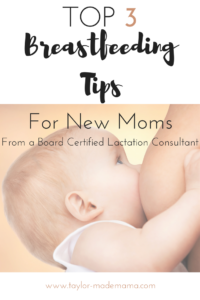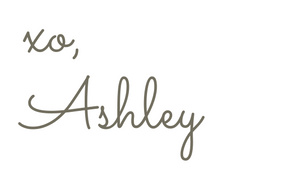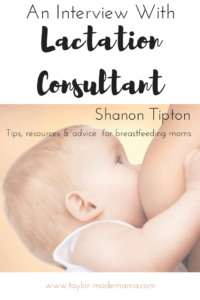Hi Mamas!
I have the pleasure of sharing with you an interview with a wonderful friend and person who also happens to be a Board Certified Lactation Consultant (IBCLC), Shanon Tipton. I’ve known Shanon for 5+ years now (we met through CrossFit actually!) and not only is she salt of the earth and the most fit mama I know (seriously, it’s insane), but she is also really, really knowledgable about all things breastfeeding and babies. I’m so excited for you to get to know her too and benefit from her wealth of knowledge as much as I have.
My daughter Taylor was born on April 15th, and we had her first wellness check in appointment at the hospital on April 16th. Who was our Charge Nurse/Lactation Consultant in the Pediatric Clinic, completely by coincidence divine intervention? Shanon! What a huge blessing she was to me that day and the weeks that followed. To be honest, I was a complete emotional mess at that appointment – like literally could not stop crying because, hormones – and was so stressed over breastfeeding. First of all, nursing was SUPER painful, and secondly I was incredibly anxious to make sure my milk came in. Looking back, I put so much pressure on myself to have everything all figured out and it freaked me out to not know what on earth I was doing as a mom. Shanon calmed and reassured me that day, and I was able to text her so many questions in the subsequent days that made all the difference in establishing the breastfeeding relationship I so wanted with my baby girl – from what I know, stress is NOT a milk supply booster! I’ve been breastfeeding now for 7.5 months while working outside the home, with (for the most part) success! Check out my top 10 must haves for breastfeeding here and how I built up a breastmilk freezer stash while I was still on maternity leave.
Okay, okay I’m sure you’re thinking, “get to the good stuff already!” so without further ado, here is my interview with Lactation Consultant, Shanon Tipton:
Hi Shanon! Thank you so much for taking the time to answer some questions for my readers and I. I would love if you could start by telling us a little bit about you:
Cheers and congratulations on the birth of your beautiful baby! My name is Shanon Tipton, and I am a Registered Nurse, Fitness Coach, and Internationally Certified Lactation Consultant. I am very excited to share my passion for breastfeeding with you! But first, a little bit about me and my background. I am a wife and proud mother of three beautiful children. For 15 years, I worked as a Registered Nurse in Labor and Delivery helping to bring new life to the world and assisting moms with breastfeeding in the early hours postpartum. Recently, I’ve transitioned to a Pediatric Clinic where I function as a Charge Nurse and Lactation Consultant. I also earned a Bachelor of Science Degree in Exercise Physiology and have the gratifying opportunity to work with personal clients as a Fitness Coach. As a competitive athlete, mother and wife, I understand the unique challenges parents face as they learn to juggle and prioritize the demands of family, work and personal life.

What made you decide to become a lactation consultant?
My personal breastfeeding experience began twenty-one years ago with the birth of my daughter Madysn. I was a young, semi-naive, new mommy, unfamiliar with the resources available to support my desire to breastfeed my baby. I remember well the frustration at two days postpartum when my milk had not yet come in, holding a screaming, inconsolable baby. My nipples were cracked and bleeding. I was delirious from sleep deprivation and desperate for relief. That relief came in the form of a Lactation Consultant, who came to my home. I attribute my three year breastfeeding relationship with my daughter, as well as the two children who followed, to the patient and gentle guidance of this wonderful woman. It is my positive and gratifying personal experiences with breastfeeding that fueled my motivation and commitment to obtain my IBCLC (International Board Certified Lactation Consultant).
What is your favorite aspect of your job?
The most gratifying aspect of my job is assisting and supporting parents in developing a positive breastfeeding relationship with their beautiful baby. In my clinic, I have the opportunity to consult with families from 2-5 days postpartum. It’s such a fragile time. Some lucky moms are already on their way to successful breastfeeding. Others are still in the trenches of sleep deprivation, discomfort from delivery, low milk supply and latch issues. My focus is assessing and developing a feeding plan specific to each family and baby’s needs and clinical picture, providing tools and education that can be taken from the clinic into the home. It’s so fun seeing my thriving patients weeks and months later with happy parents in tow!

If you could give your top 3 tips for nursing moms to establish a successful breastfeeding relationship, what would they be?
My top 3 tips for nursing moms in establishing a successful breastfeeding relationship:
1) Be patient and consistent. Establishing a robust milk supply takes time, and learning to achieve a good latch with each feed takes practice.
2) Sleep and nutrition are vitally important during these first few weeks. Eat well, sleep when your baby sleeps, and keep that cute baby close to you. Skin to skin contact will do wonders for your milk supply, as well as yours and your baby’s emotional well-being.
3) Be kind and gentle with yourself. Contrary to what we may hear, breastfeeding does not always come naturally. It’s okay to make mistakes. It’s okay to be frustrated. It’s okay to feel like everything is falling apart. Trust in your abilities as a parent and take comfort in knowing that YOU WILL GET THROUGH THIS!
Many of my friends & readers are new and/or nursing moms. They had some questions I told them I would ask on their behalf when I got the opportunity to interview you:
“Is there a secret to keeping your milk up during a growth spurt?”
One of the many wonderful things about breastfeeding, is that it takes the guesswork out of figuring how much milk your baby needs to grow and thrive. Milk is produced on a supply and demand basis, which means that when the baby enters a growth spurt, your body adjusts naturally by increasing milk production and even changing the composition of your breast milk. Most mommies have sufficient lactation capacity to synthesize at least one-third more milk than their baby typically takes! How great and miraculous is that?!
“I started pumping right away for about 10 min after each feeding. I also had an oversupply. Would that be correlated to my pumping or do some mommas just naturally have an oversupply?”
Some women make far more milk than their baby can comfortably accommodate, which can almost be as big a problem as not making enough milk. Often times this may be a “baby problem” rather than primarily a “maternal problem”. Some babies take a little more time learning to coordinate their “suckle-swallow-breathe”. Fortunately, overproduction problems diminish as the supply and demand mechanism adjusts itself and baby’s coordination improves…about 6-8 weeks post birth. This is also about the amount of time it takes for mom’s milk supply to regulate itself to what baby takes. As far as early pumping and oversupply, my recommendations are as follows…..for moms who experience a delay in lactogenesis (milk production), and baby is losing weight, it is very beneficial to first latch baby effectively to the breast on cue, followed by 5-10 min of pumping on a low setting for additional breast stimulation. Once mom’s milk “comes in” however, I recommend these management tools…
- Offer the baby one breast at each feeding, encouraging baby to empty one side. Burp baby and offer the second breast. Start with the second breast at the next feeding.
- Pump or hand express to relieve engorgement and discomfort carefully, and only enough to relieve distention. Do not empty the breast completely. Apply a cold compress to ease discomfort.
- Feed your baby on demand. Babies have no concept of time and attempting breast feed on a schedule will only cause frustration in the early weeks of life. Ignore the clock and focus on baby’s feeding cues.
- Remember….milk is made based on baby’s growth needs. If baby is latching well and seems satisfied following feeding, there’s no real reason to pump afterwards. One less task to worry about!
“How do you wean from a nipple shield and could it be the cause (or part of) my very low and depleting supply?”
There are countless opinions and research articles with regards to nipple shield use. Professionally, I have found them to be extremely beneficial for things like flat/retracted nipples, transitioning babies from bottle to breast, and for babies with weak or disorganized suckles (preterm, neurological problems etc). Personally, the nipple shield kept me from throwing in the towel during the early days postpartum when my nipples felt like they might fall off at any moment. That said, studies show that using a shield can decrease milk intake by about 25%. BUT, if this is the only way baby can latch to the breast, 25% is a pretty good compromise. Extended use of the ultrathin silicon shield has not been shown to be detrimental in any other way. If it’s working, and mom is comfortable with using a shield, by all means don’t change what’s working. However, if mom wishes to eliminate a step in the feeding process, I suggest starting by placing the baby skin-to-skin next to the nipple, starting the feed with the shield and removing it, gradually trying feeds without the shield. Be prepared for some frustration as baby moves through the learning process. With consistency and time, and the absence of anatomical necessity of the shield, baby will be able to latch directly to the breast.
“How do I prevent clogged milk ducts?”
Clogged milk ducts are typically found in mommies who have a large milk supply who do not adequately drain each breast. You’ll know if you have one because you’ll have a reddened tender area that may be warm to the touch . You may also feel a lump and have a fever. If you experience any of these symptoms, please contact your OB/GYN for further evaluation as sometimes antibiotics may be needed. However, there are things you can do to help prevent plugged ducts/mastitis:
- Feed baby regularly on demand. Do not skip feeds!
- Make sure you’re wearing a non-constricting bra. Take note especially as to how your bra fits under your arm. This is a favorite spot for those ducts to clog. No underwire bras for breastfeeding mamas! Personally, I found great success with sports bras. They are supportive and comfortable without being restrictive, and you can pull your breast out from the top or the bottom.
If you find yourself with a plugged duct, here’s what you can do…
- Breast feed often. Begin feeding on the affected breast to promote drainage.
- Massage the breast before and during feeding to stimulate milk flow. I like to use lotion and my thumb.
- Change baby’s position during feedings to ensure drainage of all the ducts.
- Avoid all restrictive clothing. Even the straps on a baby carrier can block ducts.
- Studies have shown that Lecithin, 1600 mg daily, can alleviate and prevent clogged milk ducts.
“My babe is 6 months and didn’t gain too much in the last 2 months. Is there a way to fatten my milk? It used to be so thick and creamy and now it’s like skim milk!”
Believe it or not, the nutritional status of the mother does not appear to affect milk volume unless the mother is malnourished. Babies who are exclusively breastfed have the same or even greater weight gain in the first 3-4 months than do formula-fed babies. After this time, formula fed babies consistently weigh more than breastfed babies. Babies gain weight at different rates, and as long as baby is gaining and not losing, and the pediatrician is happy, it’s safe to relax and not worry if weight gain has slowed a bit. The macronutrient make-up, consistency and appearance of breast milk changes constantly, but hindmilk always contains at least twice the amount of fat as compared to foremilk. For mommies who are blessed with a large milk supply, it’s important to have baby COMPLETELY empty one breast before moving on to the next. This way, baby gets a full serving of fat at each meal. Unfortunately, the amount and type of fat that Mom eats doesn’t affect the total amount of fat in breastmilk. No amount of pizza and nachos is going to boost the fat content of your breast milk. Rest assured that by aiming to completely empty at least one breast before switching to the second will ensure baby is getting exactly what he needs.
“What would you suggest to boost production for moms who struggle with milk supply?”
Foods and herbs are used in many cultures to increase milk supply. There’s conflicting evidence however as to whether or not “galactagogues” (agents that promote milk production) really work. Regardless, I have many patients and clients use them with great success. My recommendation? Try them, and if you find something that works, great! The list of claimed galactagogues is long, but a few that you can find at places like Whole Foods are shatavari, torbangum, fenugreek tea and milk thistle. Believe it or not, oatmeal seems to be the shining star favorite among my patients. Healthy, tasty, AND a potential galactagogue!
Wow, I feel like I’ve learned SO much from this interview with you, but I know that other mamas out there likely have trouble-shooting and questions we didn’t have time to touch on. So, my last question is, what kind of services do you offer currently, and how could a mama get in touch with you?
Thank-you so much for your questions and for allowing me to share my personal and professional experience with you as you embark on the amazing journey that is breastfeeding. I am currently available for email and telephone consultations, and am also offering my services via text. I can be contacted at nursechata@hotmail.com. I look forward to offering support, education and guidance tailored to you and your baby’s individual needs.
Thank you SO much for sharing your time and expertise with us, Shanon! I know you’ll continue to help mamas across the country to feel more confident and successful in their breastfeeding journeys.
What other breastfeeding related questions do you still have?

P.S. If you’re still nursing, make sure to check out all my posts on breastfeeding & pumping.
- Top Tips For Successfully Pumping At Work
- Top 10 Breastfeeding Must-Haves For New Moms
- What’s In My Pumping Bag
- The Best Lactation Cookie Recipe
- Working, Pumping and Breastfeeding Mama’s Workday Routine
- How To Build and Store a Freezer Stash Of Breastmilk on Maternity Leave


This is a great post Ashley ! Thanks for sharing this information and taking out the time.
My pleasure, Arushi! Shanon was such an integral resource to me and I know many new, nursing mamas may be looking for this kind of info/support.
Great advice! but I especially appreciate the advice on the clogged ducts. I’ve experienced them with both of my children and the more tips to avoid the better! Thank you!
I’m so glad that piece was helpful, Michele!
Such a neat post! I love reading things from people who absolutely love their jobs:)
Me too, Joanna – Shanon is so passionate about helping new moms find success in their breastfeeding journeys and it really shines through here!
Great interview? I have had a clogged milk duct and would have never known that Lecithin helps. I’m ordering it online asap. Thanks for this.
You’re most welcome, Natalie! I’m so glad you read something you can implement to help.
Such a helpful interview! Totally bookmarking this for #3!
I learned so much from this interview as well, Val! I hope you and Baby #3 get off to any easy start with nursing!